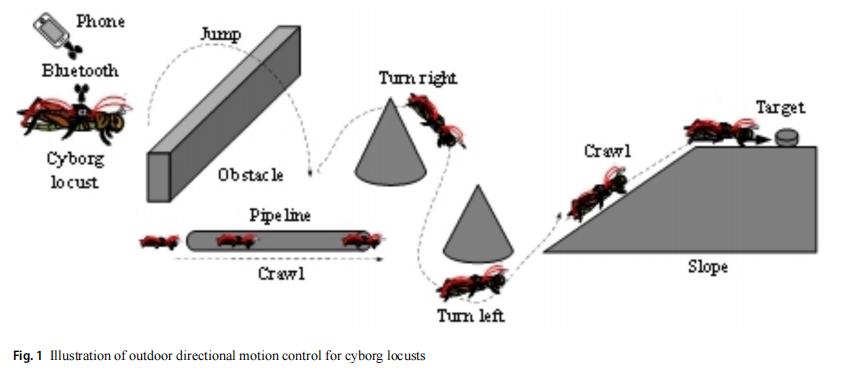Journal of Bionic Engineering (2025) 22:596–607 https://doi.org/10.1007/s42235-024-00639-8
A Directional Locomotion Control of Cyborg Locusts for Complex Outdoor Environments
Xin Huang1,2 · Tiancheng Li1,2 · Kaixuan Sun1,2 · Meisong Yuan1,2 · Bo Yang1,2
1 School of Instrument Science and Engineering, Southeast University, Nanjing 210096, China
2 Key Laboratory of Micro-Inertial Instruments and Advanced Navigation Technology, Ministry of Education, Nanjing 210096, China
Abstract
he ability of cyborg locusts to achieve directional movement in complex outdoor environments is critical for search and rescue missions. Currently, there is a lack of research on motion control for cyborg locusts in outdoor settings. In this study, we developed cyborg locusts capable of performing directional locomotion in intricate outdoor environments, including jumping over obstacles, climbing slopes, traversing narrow pipelines, and accurately reaching predetermined targets along specified routes. We designed a miniature electrical backpack (10 mm × 10 mm, 0.75 g) capable of receiving stimulus parameters (frequency, duty ratio, and stimulation time) via Bluetooth commands from mobile phones. Electrical stimulation of locust sensory organs, such as the antennae and cercus, induced turning and jumping behaviors. Experimental testing of locust movement control was conducted under outdoor conditions with a short electrical stimulation interval. Results showed a positive correlation between locust turning angles and electrical stimulation parameters within a specified range, with an average jumping height exceeding 10 cm. Additionally, the success rate of locust turning and jumping behaviors correlated positively with the interval time between electrical stimulations. Adjusting these intervals during forward crawling phases increased the likelihood of the locusts jumping again. In conclusion, this study successfully achieved directional locomotion control of cyborg locusts outdoors, providing insights and references for advancing search and rescue capabilities.
Keywords Cyborg locusts · Turning and jumping control · Directional locomotion · Search and rescue

Copyright © 2025 International Society of Bionic Engineering All Rights Reserved
吉ICP备11002416号-1









